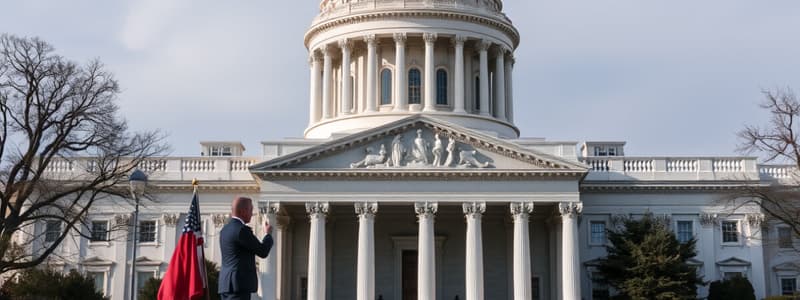Podcast
Questions and Answers
What is the primary function of a veto in government?
What is the primary function of a veto in government?
- To cancel or postpone decisions made by another branch (correct)
- To enforce laws
- To initiate new legislation
- To conduct elections
Which branch of government is typically associated with the power to veto?
Which branch of government is typically associated with the power to veto?
- Executive branch (correct)
- Administrative branch
- Legislative branch
- Judicial branch
What can occur if a veto is exercised by the executive branch?
What can occur if a veto is exercised by the executive branch?
- The judicial branch reviews the decision
- The law is immediately implemented
- The decision can be overridden by a majority vote in the legislative branch (correct)
- The veto is permanent and cannot be challenged
Which scenario best illustrates the concept of a veto?
Which scenario best illustrates the concept of a veto?
In which situation would a veto likely be used?
In which situation would a veto likely be used?
Study Notes
Veto Function in Government
- A veto serves as a mechanism for an executive to reject legislation passed by the legislative branch.
- It acts as a check on legislative power, ensuring that laws meet certain standards or reflect executive approval.
Branch of Government Associated with Veto Power
- The executive branch, typically represented by the president or governor, holds the authority to veto legislation.
- This power is integral to the separation of powers principle, aimed at preventing any one branch from becoming too powerful.
Consequences of Exercising a Veto
- When a veto is exercised, the legislation does not become law unless the legislature overrides the veto, usually requiring a supermajority vote.
- This action can lead to political negotiation, lobbying, or reevaluation of the proposed law by the legislative body.
Illustrative Scenario of a Veto
- A president vetoing a spending bill that they believe exceeds budgetary constraints exemplifies the concept of a veto in action.
- This scenario highlights the executive's role in fiscal responsibility and checks on legislative decisions.
Situations Likely to Prompt a Veto
- A veto is often used in cases where proposed legislation conflicts with the executive's policies or contradicts their agenda.
- It may also arise in instances where bipartisan support for a bill is lacking, signaling potential disagreement or risk to governance principles.
Studying That Suits You
Use AI to generate personalized quizzes and flashcards to suit your learning preferences.
Description
Explore the crucial concept of the veto power within government structures. This quiz covers the primary functions of a veto, its association with government branches, and scenarios illustrating its usage. Challenge your understanding of this important political tool!




